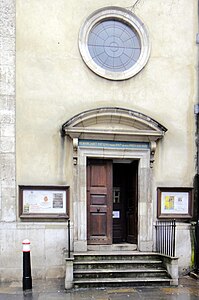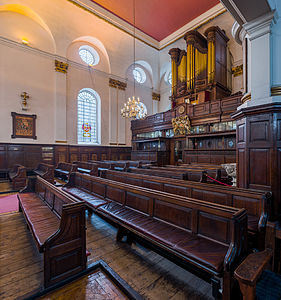St Margaret Pattens
| St Margaret Pattens | |
|---|---|
 View of the church from Plantation Lane | |
 | |
| Location | London, EC3 |
| Country | United Kingdom |
| Denomination | Anglican |
| Architecture | |
| Heritage designation | Grade I listed building |
| Architect(s) | Sir Christopher Wren |
| Administration | |
| Diocese | London |
St Margaret Pattens is a Church of England church in the City of London, located on Eastcheap near the Monument. The dedication is to Saint Margaret of Antioch.
History
[edit]The church was first recorded in 1067, at which time the church was probably built from wood.[1] It was rebuilt in stone at some unknown subsequent date but fell into disrepair and had to be demolished in 1530. It was rebuilt in 1538[2] but was destroyed in the Great Fire of London in 1666.[3] The present church was built by Sir Christopher Wren in 1687.[4] It is one of only a few City churches to have escaped significant damage in the Second World War.
In 1954 St Margaret Pattens ceased to be a parish church[5] and became one of the City’s guild churches, within the living of the Lord Chancellor and under the jurisdiction of the Bishop of London. They have a regular weekday, rather than Sunday congregation, drawn mostly from people who work in offices nearby. The tower accommodates the office of the Archdeacon of Hackney.
The church was designated a Grade I listed building on 4 January 1950.[6]
Building
[edit]The church's exterior is notable for its 200-ft high spire, Wren's third highest and the only one that he designed in a medieval style.[7] This is sometimes referred to as Wren's only "true spire". The church’s interior is a simple rectangle with some unusual fittings – the only canopied pews in London, dating from the 17th century. These were intended for the churchwardens. The initials "CW" which appear in one of the pews have been thought to refer to Christopher Wren, but they may also signify "church warden." Other features in the interior include a punishment box carved with the Devil's head where wrongdoers had to sit during the church service.
Name
[edit]The church's name is traditionally said to derive from pattens, wooden-soled overshoes, later soled with raised iron rings, that, as elsewhere, parishioners would be asked to remove on entering the church.[8] These raised shoes enabled people to walk about the streets of London without muddying their feet. The church has certainly long been associated with their Livery Company, The Worshipful Company of Pattenmakers.[9]
Another possibility is that the church's name actually commemorates a benefactor, possibly one Ranulf Patin, a canon at St Paul's Cathedral during the medieval period, although it would be most unusual for a benefactor to be commemorated in this way.
Gallery
[edit]-
Entrance to the church
-
Looking east towards the altar
-
Looking west to the entrance and organ
-
Looking diagonally across to the organ
-
Looking diagonally across to the altar
See also
[edit]- 30 Fenchurch Street
- Eastcheap
- List of churches and cathedrals of London
- List of Christopher Wren churches in London
Notes
[edit]- ^ "The City of London Churches: monuments of another age" Quantrill, E; Quantrill, M p70: London; Quartet; 1975
- ^ "London:the City Churches” Pevsner,N/Bradley,S New Haven, Yale, 1998 ISBN 0-300-09655-0
- ^ "The City Churches" Tabor, M. p82:London; The Swarthmore Press Ltd; 1917
- ^ "The Visitors Guide to the City of London Churches" Tucker,T: London, Friends of the City Churches, 2006 ISBN 0-9553945-0-3
- ^ "The London Encyclopaedia" Hibbert,C;Weinreb,D;Keay,J: London, Pan Macmillan, 1983 (rev 1993,2008) ISBN 978-1-4050-4924-5
- ^ Historic England. "Details from listed building database (1286593)". National Heritage List for England. Retrieved 23 January 2009.
- ^ "The Old Churches of London" Cobb,G: London, Batsford, 1942
- ^ "The City of London Churches" Betjeman,J Andover, Pikin, 1967 ISBN 0-85372-112-2
- ^ "Worshipful Company of Pattenmakers". Worshipful Company of Pattenmakers. Retrieved 10 April 2009.





